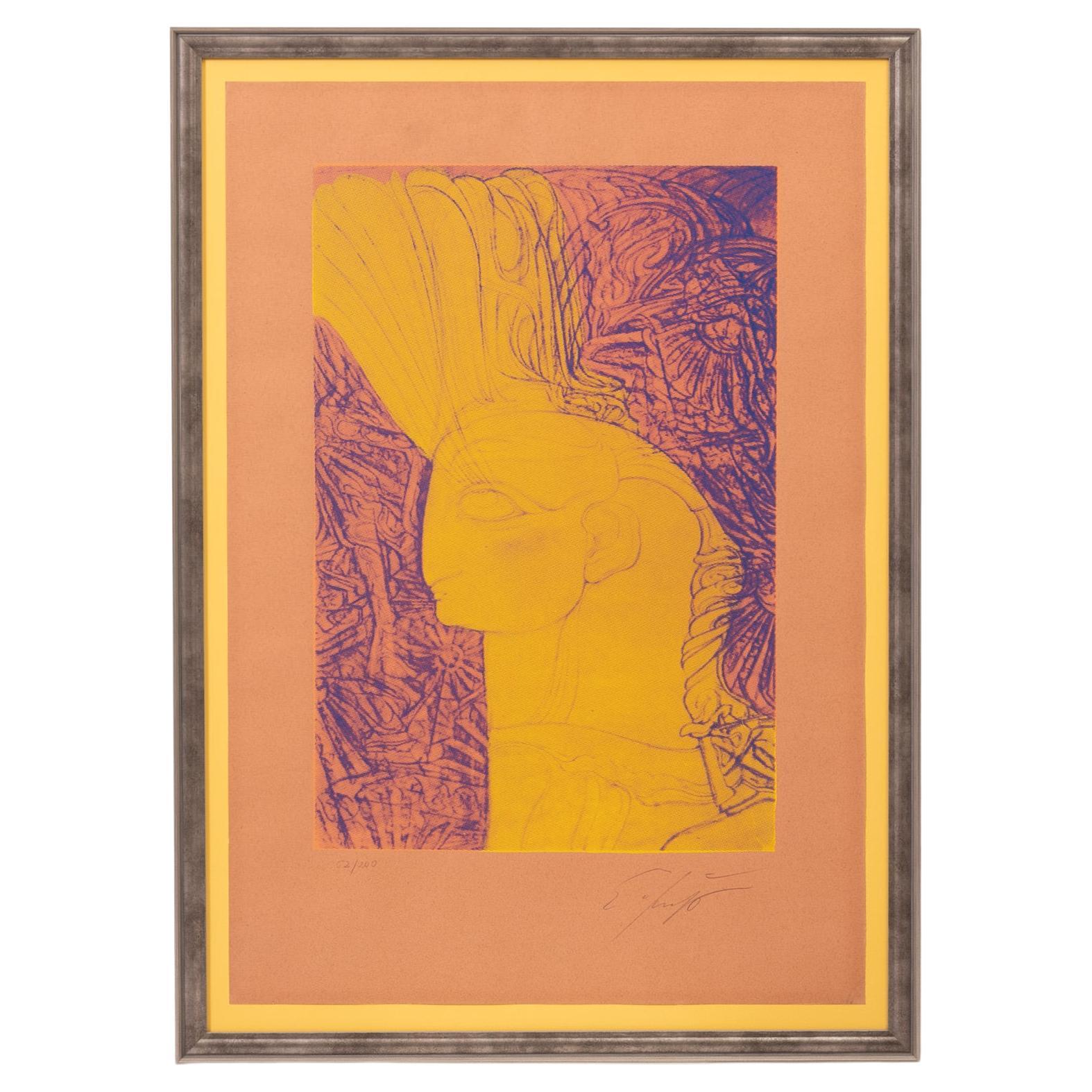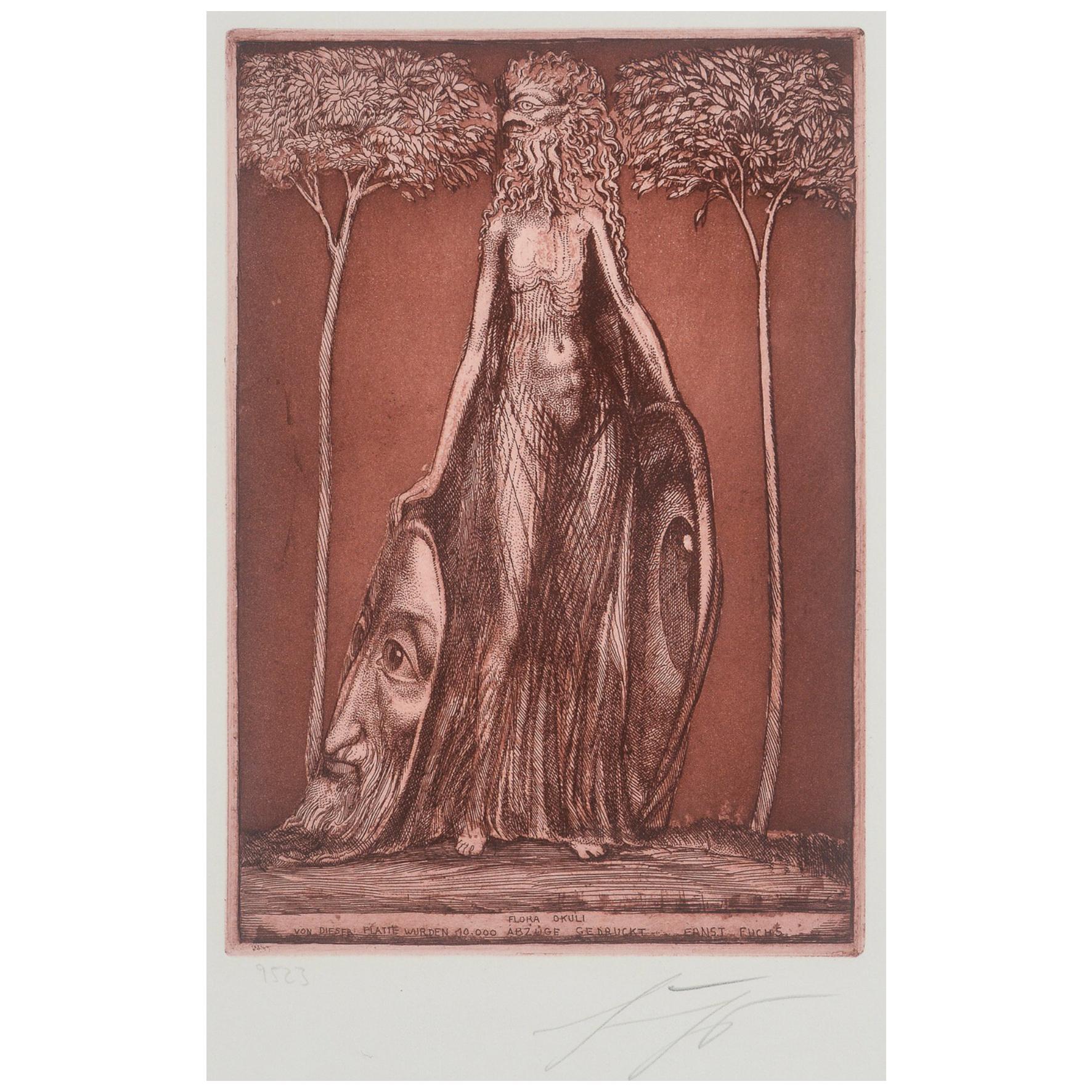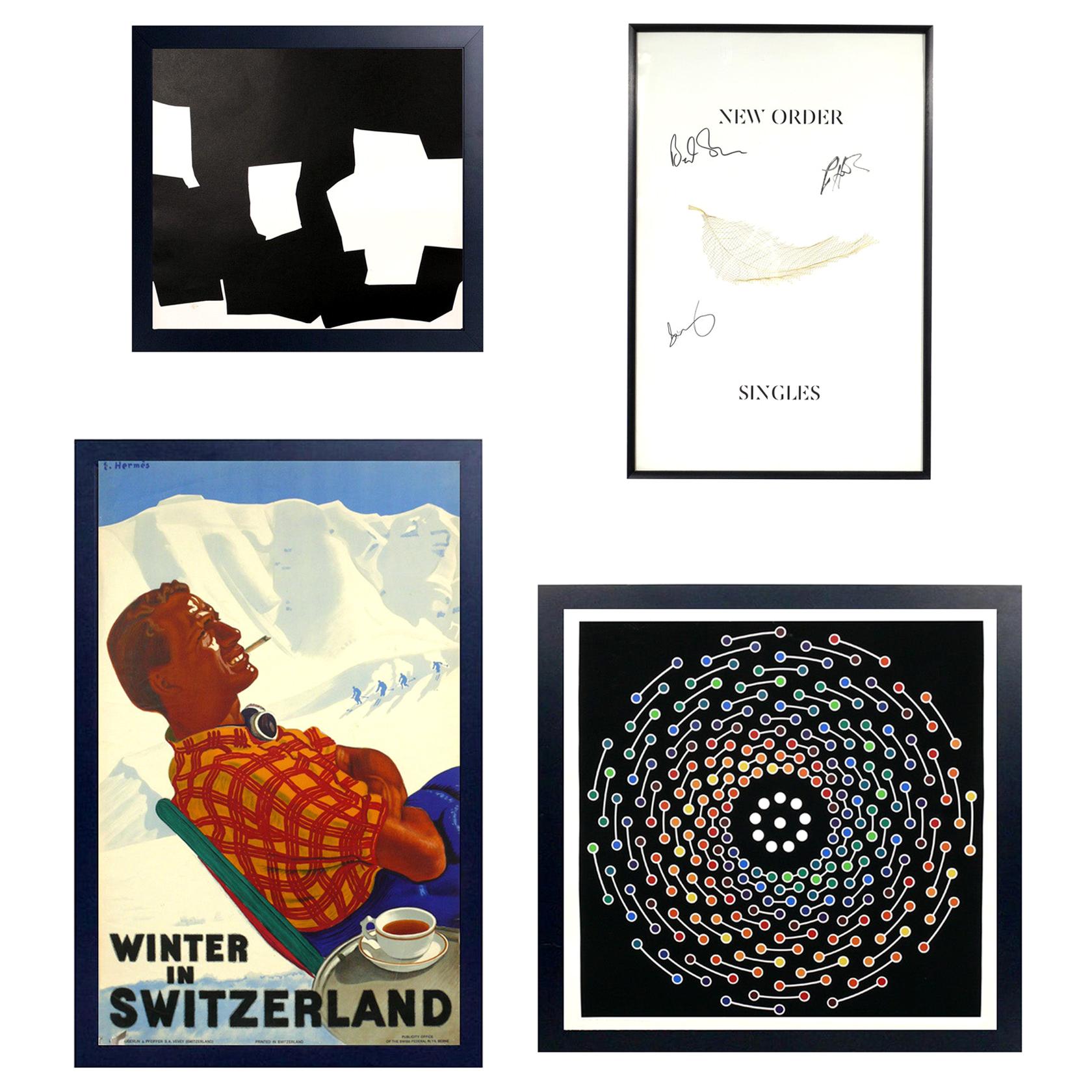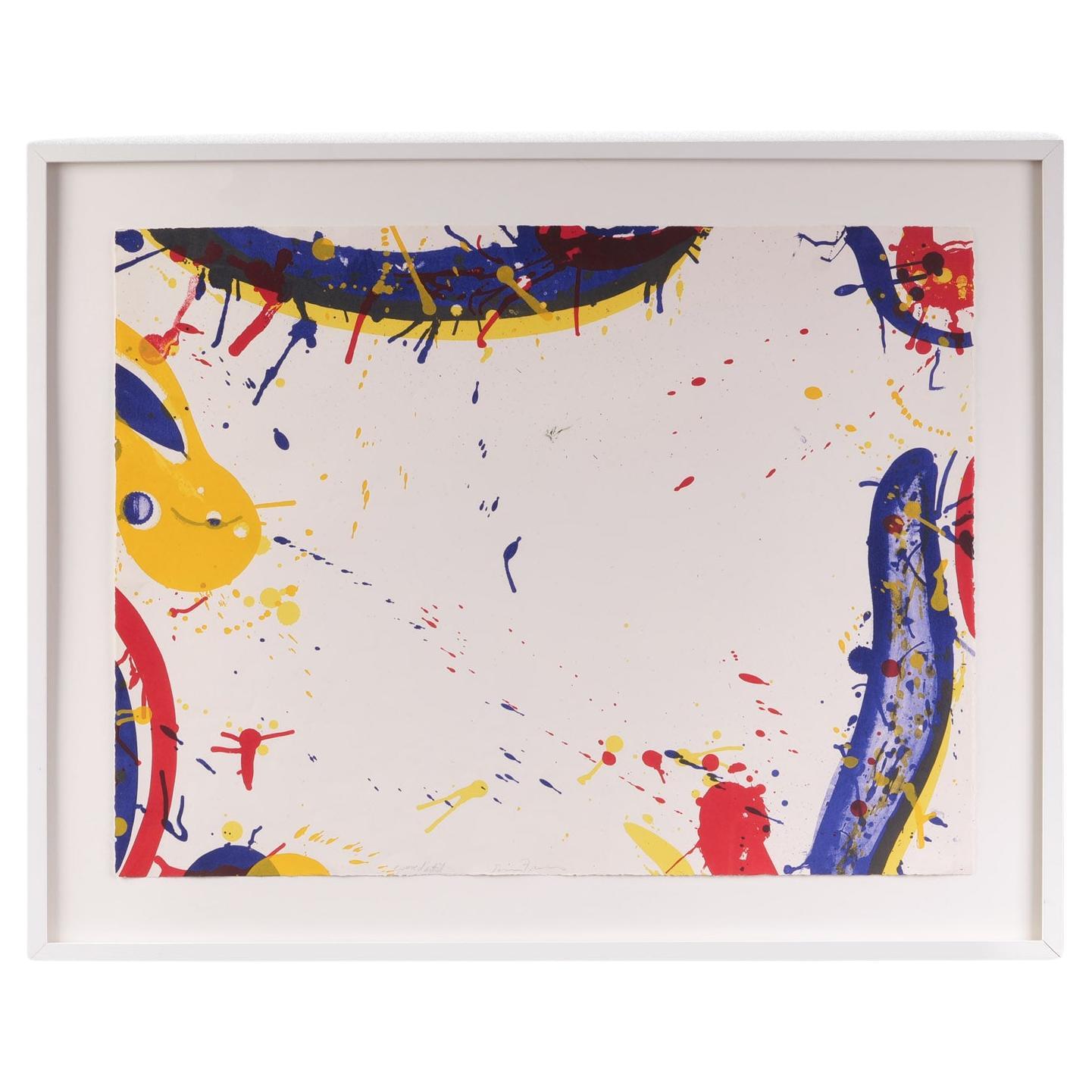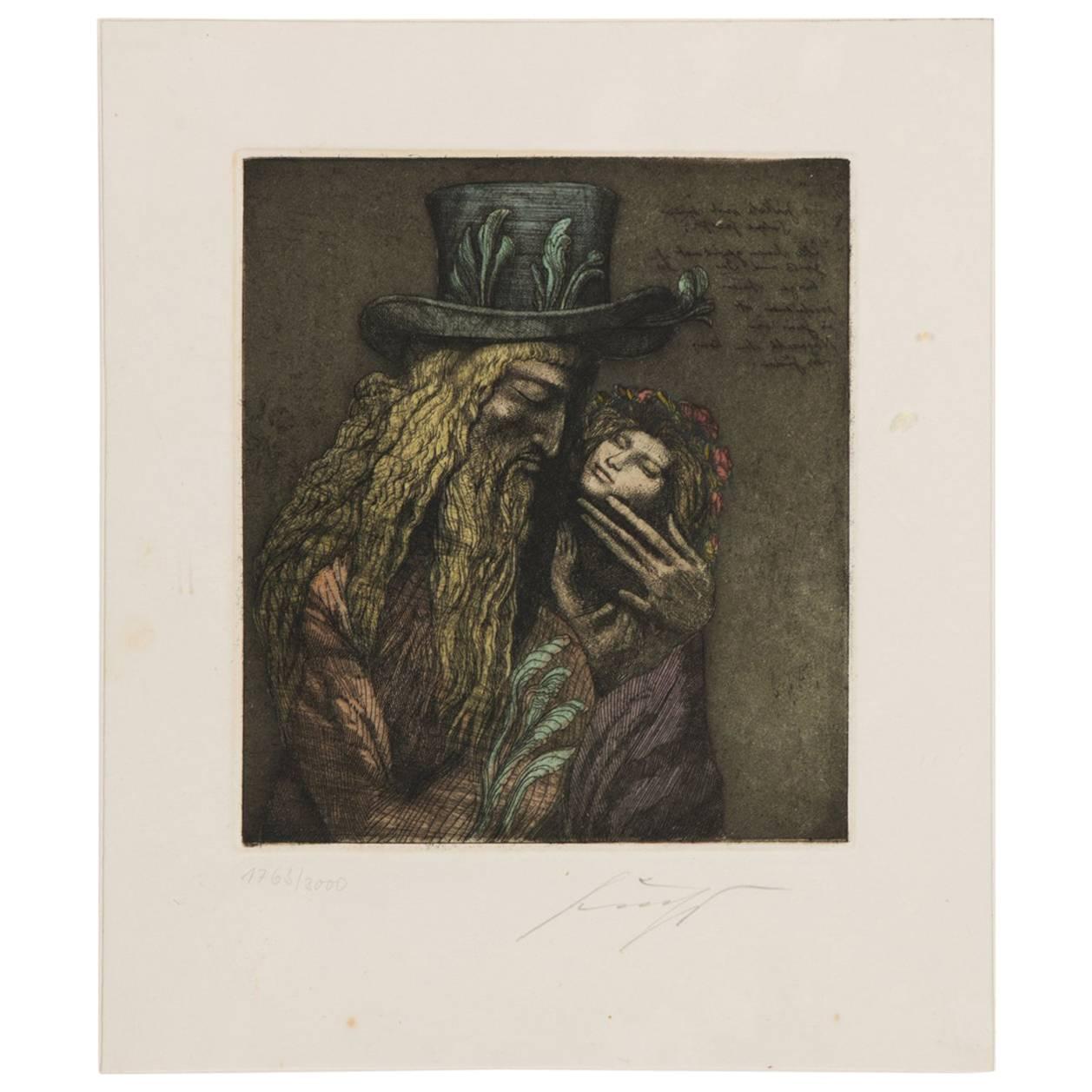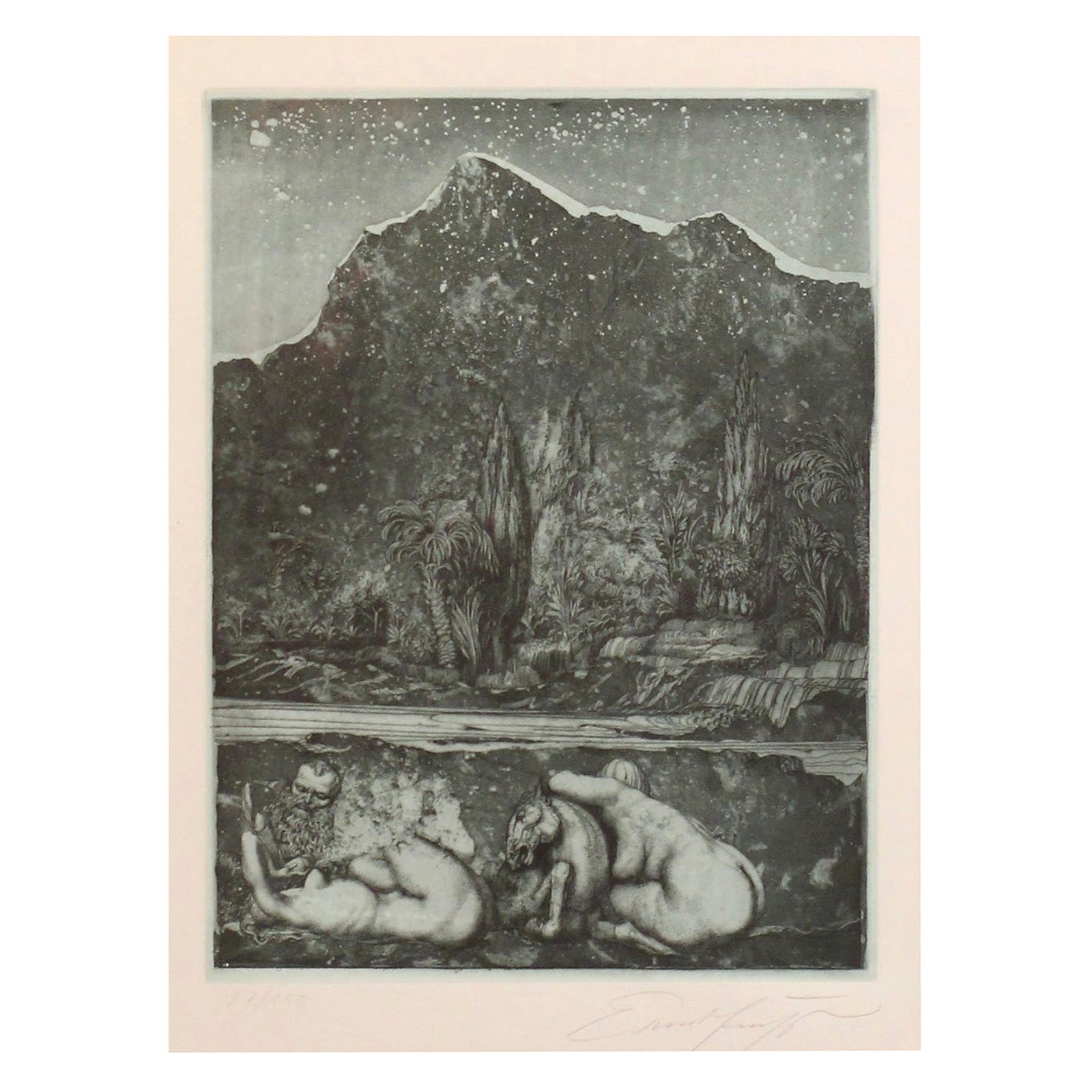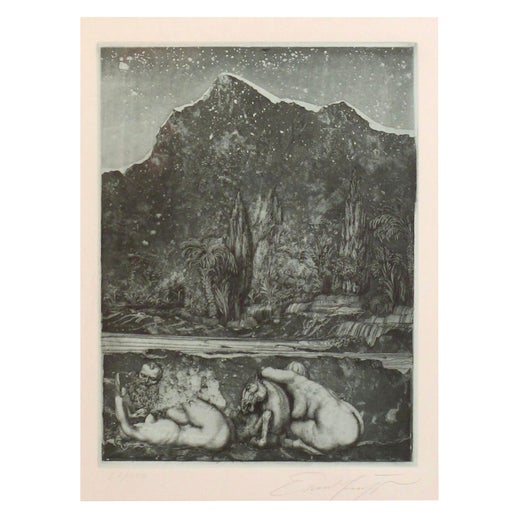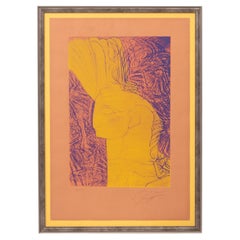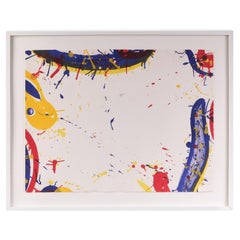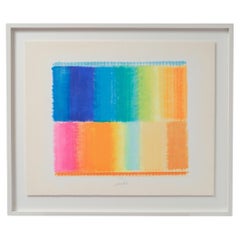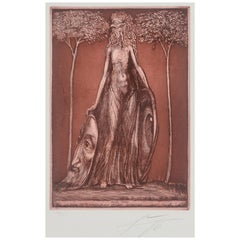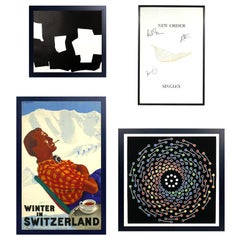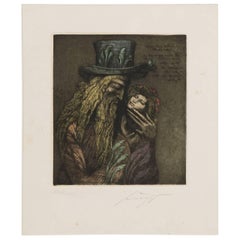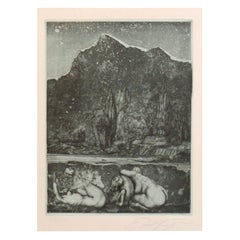Items Similar to Ernst Fuchs (1930 - 2015) "Head of a cherub", created in 1982 Color silkscreen
Want more images or videos?
Request additional images or videos from the seller
1 of 5
Ernst Fuchs (1930 - 2015) "Head of a cherub", created in 1982 Color silkscreen
About the Item
Ernst Fuchs (1930 - 2015)
"Head of a cherub", created in 1982
Color silkscreen, ed. 200 pieces, signed and numbered
Dimensions 67.7 cm x 45 cm
Ernst Fuchs was born on February 13, 1930 in Vienna Ottakring as the only child of Maximilian and Leopoldine Fuchs; his father was of Jewish descent, which is why his grandfather and father emigrated to the USA and Shanghai in 1938 after the annexation of Austria by the Third Reich. To protect little Ernst from anti-Semitic hostility, it was decided to baptize him according to the Roman Catholic rite in 1942. The 12-year-old Ernst Fuchs was allowed to choose his own baptismal name and chose Ernst Peter Paul, in honor of the painter Peter Paul Rubens, whom he admired at the time. Around the same time, his godmother's brother, the painter and restorer Alois Schiemann, taught him the basics of drawing and painting. Until the age of 15, he attended the St. Anna painting school in Vienna, where he was taught sculpture and painting by Emmy Steinböck and Fritz Fröhlich.
After the war, Ernst Fuchs was finally able to take up his longed-for studies at the Academy of Fine Arts in Vienna, which he had previously been denied for racist reasons. His teachers were first Robin Andersen, then Albert Paris Gütersloh. While still a student, he was allowed to hold his first solo exhibition in Paris in 1949, and soon afterwards, in 1950, he also moved to the French capital. Ernst Fuchst traveled through Europe and the USA for six years before taking an extended stay at the Dormition Monastery on Mount Zion in Israel in 1957 to study icon painting in depth. He finally returned to Vienna in 1962, where he founded the Vienna School of Fantastic Realism with former fellow students, of which he himself was to become the most important representative. The early years in particular were characterized by a strong surrealism; mythical and religious symbols in particular appealed to Ernst Fuchs and permeated his work. Later, Fuchs turned increasingly to Mannerism.
Ernst Fuchs' artistic spectrum broadened over the years: he sang and recorded various albums, which, like the majority of his paintings, were inspired by mystical motifs, and he designed stage sets for such famous operas as Wagner's Parsifal and Lohengrin or Mozart's Die Zauberflöte. Ernst Fuchs also wrote philosophical treatises. He repeatedly collaborated with other artists, including the musicians Klaus Schulze and Chris Karrer. For years, he cultivated friendships with greats such as Hundertwasser, Dalí and Breker; in the 1990s, he designed various buildings in his own fantastic style with rich ornamentation and powerful colors. A curiosity in his long artistic biography is probably the design of a BMW 635 CSI, the "Fire Fox on a Hare Hunt".
Ernst Fuchs was married four times, had multiple relationships and was the father of sixteen children. He died on November 9, 2015 in Vienna. The name Ernst Fuchs is associated with prizes and awards of all kinds as well as a rich artistic legacy of a musical, painterly and literary nature.
- Creator:Ernst Fuchs (Artist)
- Dimensions:Height: 26.66 in (67.7 cm)Width: 17.72 in (45 cm)Depth: 1.19 in (3 cm)
- Style:Modern (Of the Period)
- Materials and Techniques:
- Place of Origin:
- Period:1980-1989
- Date of Manufacture:1982
- Condition:Wear consistent with age and use.
- Seller Location:Münster, DE
- Reference Number:1stDibs: LU9172238441112
Ernst Fuchs
Ernst Fuchs was a very poliedric artist. He was a painter, draftsman, printmaker, sculptor, architect, stage designer, composer, poet, singer and one of the founders of the Vienna School of Fantastic Realism. In 1972, he acquired the derelict Otto Wagner Villa in Hütteldorf, which he restored and transformed. The villa was inaugurated as the Ernst Fuchs Museum in 1988.
About the Seller
5.0
Recognized Seller
These prestigious sellers are industry leaders and represent the highest echelon for item quality and design.
Established in 2000
1stDibs seller since 2023
- ShippingRetrieving quote...Shipping from: Münster, Germany
- Return Policy
Authenticity Guarantee
In the unlikely event there’s an issue with an item’s authenticity, contact us within 1 year for a full refund. DetailsMoney-Back Guarantee
If your item is not as described, is damaged in transit, or does not arrive, contact us within 7 days for a full refund. Details24-Hour Cancellation
You have a 24-hour grace period in which to reconsider your purchase, with no questions asked.Vetted Professional Sellers
Our world-class sellers must adhere to strict standards for service and quality, maintaining the integrity of our listings.Price-Match Guarantee
If you find that a seller listed the same item for a lower price elsewhere, we’ll match it.Trusted Global Delivery
Our best-in-class carrier network provides specialized shipping options worldwide, including custom delivery.More From This Seller
View AllErnst Fuchs (1930 - 2015) "Head of a cherub", created in 1982 Color silkscreen
By Ernst Fuchs
Located in Münster, DE
Ernst Fuchs (1930 - 2015)
"Head of a cherub", created in 1982
Color silkscreen, ed. 200 pieces, signed and numbered
Dimensions 67.7 cm x 45 cm
Ernst Fuchs was born on February 13, 1930 in Vienna Ottakring as the only child of Maximilian and Leopoldine Fuchs; his father was of Jewish descent, which is why his grandfather and father emigrated to the USA and Shanghai in 1938 after the annexation of Austria by the Third Reich. To protect little Ernst from anti-Semitic hostility, it was decided to baptize him according to the Roman Catholic rite in 1942. The 12-year-old Ernst Fuchs was allowed to choose his own baptismal name and chose Ernst Peter Paul, in honor of the painter Peter Paul Rubens, whom he admired at the time. Around the same time, his godmother's brother, the painter and restorer Alois Schiemann, taught him the basics of drawing and painting. Until the age of 15, he attended the St. Anna painting school in Vienna, where he was taught sculpture and painting by Emmy Steinböck and Fritz Fröhlich.
After the war, Ernst Fuchs was finally able to take up his longed-for studies at the Academy of Fine Arts in Vienna, which he had previously been denied for racist reasons. His teachers were first Robin Andersen, then Albert Paris Gütersloh. While still a student, he was allowed to hold his first solo exhibition in Paris in 1949, and soon afterwards, in 1950, he also moved to the French capital. Ernst Fuchst traveled through Europe and the USA for six years before taking an extended stay at the Dormition Monastery on Mount Zion in Israel in 1957 to study icon painting in depth. He finally returned to Vienna in 1962, where he founded the Vienna School of Fantastic Realism with former fellow students, of which he himself was to become the most important representative. The early years in particular were characterized by a strong surrealism; mythical and religious symbols in particular appealed to Ernst Fuchs and permeated his work. Later, Fuchs turned increasingly to Mannerism.
Ernst Fuchs' artistic spectrum broadened over the years: he sang and recorded various albums, which, like the majority of his paintings, were inspired by mystical motifs, and he designed stage sets for such famous operas as Wagner's Parsifal and Lohengrin or Mozart's Die Zauberflöte. Ernst Fuchs also wrote philosophical treatises. He repeatedly collaborated with other artists, including the musicians Klaus Schulze...
Category
Vintage 1980s Austrian Modern Contemporary Art
Materials
Paper
Sam Francis "Jubilee" color lithograph, created 1964
By Sam Francis
Located in Münster, DE
Sam Francis (1923 San Mateo - 1994 Santa Monica)
"Jubilee" color lithograph, created 1964, edition of 50 copies, signed, numbered and dated, Ex.: e.a.
Dimensions: 50.5 x 65.5 cm
Sam Francis was an American painter and graphic artist. His work is classified as Abstract Expressionism or Color Field Painting
Sam Francis is one of the most important American artists, born in San Mateo (California) in 1923, died in Santa Monica in 1994. After a plane crash during his service in the US Air Force, he began painting in 1944 during his convalescence and then studied under David Park at the California School of Fine Arts in San Francisco. His early abstractions, which are still reminiscent of Clyfford Still and Jackson Pollock, show spontaneous painterly gestures that led to the typically American "all over" structure: the canvas is completely covered with dots, spots, marks and other traces of the painter's brush. When Francis was in Paris from 1950 to 1957, he abandoned color and broke new ground with works such as "White Painting" (1950). But as early as the summer of 1951 in the south of France, he used pink and red again, only to return to the full palette later on. Sometimes he used all the colors and their variations in tone, sometimes he let one color dominate, as in "Blue Balls" (1960). Although Francis has been associated with Color Field painting, this must be seen as an aid to classification, to help one come to terms with a highly original visual language.
When "fields" appear in Francis' work, they are almost never (if ever) color fields. Instead, they have an interplay of foreground and background. They often create depth, which makes the canvas more of a "color space".
It is typical of Sam Francis' pictorial strategies that he often leaves the center of the picture free...
Category
Vintage 1960s American Modern Contemporary Art
Materials
Paint, Paper
Heinz Mack (*1931 Lollar) “untitled” Color silkscreen, 2013
Located in Münster, DE
Heinz Mack (*1931 Lollar)
“untitled”
Created in 2013
Color silkscreen on wove paper, signed, numbered and dated by hand
EX. 31/70
framed behind museum glass
Dimensions:
She...
Category
2010s German Modern Contemporary Art
Materials
Paint, Paper
Gerhard Uhlig Watercolor “untitled”, created in 1984
Located in Münster, DE
Gerhard Uhlig (1926-2015)
Watercolor “untitled”, created in 1984, signed and dated by hand, framed behind glass
Dimensions:
Frame size: 43 x 34 cm
Sheet size: 15 x 10 cm
Gerha...
Category
Vintage 1980s German Modern Contemporary Art
Materials
Paint, Paper
Georg Karl Pfahler “untitled” Color silkscreen on wove paper 1989
Located in Münster, DE
Georg Karl Pfahler (1926 - 2002)
“untitled”
Color silkscreen on wove paper, versa signed, numbered and dated by hand
Creation 1989
EX. 23/50
framed behind glass
Dimensions:
70 x 70 cm
Georg Karl Pfahler is considered the only important representative of the Hard Edge in Germany; he was a guest at the Biennales in Venice and São Paolo, taught in Nuremberg and Salzburg and was awarded numerous prizes.
Georg Karl Pfahler was born on October 8, 1926 in Emetzheim, Bavaria. He spent his childhood and youth on his parents' farm, far away from any art. Nevertheless, he loved painting and drawing from an early age and cultivated it intensively as a childhood pastime. However, Georg Karl Pfahler only received the impetus to study art in 1948 when he met students from the Nuremberg Art Academy and accepted their invitation. His parents, good but simple country folk, had no interest in their son's newly awakened passion, and the young man was also met with incomprehension in his home village. However, Georg Karl Pfahler did not let this put him off, but attended the Academy of Fine Arts in Nuremberg for two years, where he came into contact with original art for the first time and became acquainted with the works of Marc Chagall and Paul Klee. After two semesters, he moved to Stuttgart to study under Willi Baumeister, Gerhard...
Category
Vintage 1980s German Modern Contemporary Art
Materials
Paint, Paper
Fritz Winter "black, light English red " color aquatint of 2 plates, 1967
Located in Münster, DE
Fritz Winter (1905 Altenbögge - 1976 Herrsching am Ammersee)
“black, light English red”
Color aquatint of 2 plates, created in 1967
Edition of 100 numbered and signed copies on Ri...
Category
Vintage 1960s German Modern Contemporary Art
Materials
Paint, Paper
You May Also Like
Ernst Fuchs Etching Flora Okuli
By Ernst Fuchs
Located in Vienna, AT
Ernst Fuchs "Flora Okuli"
Etching on handmade paper number 9523/10000, sign. Measures: 24 x 16.5 (43 x 31.5) cm.
Category
Vintage 1960s Austrian Prints
Selection of Color Modern Lithographs and Silkscreens
Located in Atlanta, GA
Selection of color modern lithographs and silkscreens, circa 1930s-2000s. They have been framed in clean lined black lacquer gallery frames under UV resistant glass. They are:
Top row, left to right:
1) Black and white abstract lithograph by Eduardo Chillida, circa 1960s. It measures: 21.25" H x 23.25" W.
2) Color silkscreen New Order "Singles" poster, signed by three members of the band, circa 2005. It measures: 30.25" H x 20.25" W.
Bottom row, left to right:
3) Switzerland Ski Travel Color Silkscreen Poster, circa 1930s. It measures: 43" H x 27.75" W.
4) Abstract color lithograph, entitled "Spectral" by John...
Category
Vintage 1960s French Mid-Century Modern Prints
Materials
Glass, Wood, Paper
Ernst Fuchs "Jakob Und Joseph" Etching, 1976
By Ernst Fuchs
Located in Vienna, AT
Ernst Fuchs
"Jacob and Joseph"
etching
Hand signed, numbered, 1763/3000
Edition 3000 copies.
Format of display:
18.5 x 16.5cm, on handmade paper 29 x 24cm in glued in passepart...
Category
Vintage 1970s Austrian Paintings
Materials
Paper
Ernst Fuchs 'Under the Snow Lilith' Print, 1969
By Ernst Fuchs
Located in Los Angeles, CA
Surreal dry point etching, 'Under the Snow Lilith' by Ernst Fuchs, signed lower left, right, numbered '27/150,' mounted and framed, panel size: 10.5" x 13.5" (without frame).
Category
Vintage 1960s German Mid-Century Modern Prints
Materials
Paper
New Breed Bay A 72 Color Silkscreen by Erik Parker
By Erik Parker
Located in Stamford, CT
A72 color silkscreen on paper. Published by Pace Editions, Inc., New York 2017. Edition of 50. Signed, numbered and dated by the artist. Newly framed in a 23-karat yellow gold leaf f...
Category
2010s American Modern Contemporary Art
Materials
Paper
"Road To Rio", a 22 Color Silkscreen by Howard Hodgkin
By Howard Hodgkin
Located in Stamford, CT
A 2016 silkscreen print made on the occasion of the Rio Olympics titled "Road To Rio" by Howard Hodgkin. Numbered 88/350 signed H.H. and dated 2016 in pen...
Category
2010s English Modern Contemporary Art
Materials
Paper
